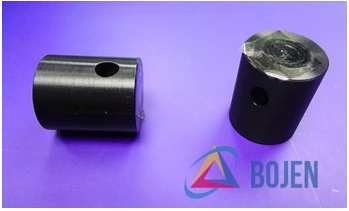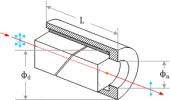Description
The Glan-Taylor Polarizer is a precision optical device crafted from two identical birefringent material prisms, separated by an air gap. This design is particularly effective for applications requiring low to medium power. The polarizer features an escape window on one side, allowing it to split an incoming unpolarized light beam into two distinct rays. The extraordinary ray is transmitted through the polarizer, while the ordinary ray is internally reflected and absorbed. This unique separation of light components makes the Glan-Taylor Polarizer an essential tool for achieving high-quality polarization.
Engineered to eliminate the reflected ordinary polarization component of a light beam, Glan-Taylor polarizers are designed to ensure that only the transmitted extraordinary ray is utilized for applications demanding a high-quality, polarized light source. The escape window allows a significant portion of the reflected light, including all of the ordinary ray and some of the extraordinary ray, to exit the polarizer. Consequently, the escape beam is not fully polarized, emphasizing the importance of the transmitted extraordinary ray for precise applications.
These polarizers are optimized for use with well-collimated light beams. It is crucial to note that converging and diverging input beams will not achieve the correct polarization and incidence angle at the internal interface. The Glan-Taylor Polarizer is meticulously designed to work with specific light conditions, ensuring optimal performance and reliability in various optical applications.
Glan-Taylor Polarizers
Specifications
| Material: | Calcite, a-BBO |
|---|---|
| Transmission Wavelength Range: | 400 – 700 nm |
| Max Extinction Ratio: | Not Available |
| Wavefront Distortion: | <= Lambda/4 |
| Surface Quality (Input, Output Faces): | 20-10 scratch-dig |
| Clear Aperture: | 6 mm |
Features
- Clear Aperture: Available in sizes 36.0mm, 38.0mm, 10.0mm, and 15.0mm.
- Scratch & Dig: 20/10 for superior optical quality.
- Transmitted Wavefront Distortion: λ/4, ensuring precise beam quality.
- Beam Deviation: Less than 3 arc minutes for accurate beam alignment.
- Material: Made from high-quality a-BBO or Calcite for excellent birefringence.
- Coating: Single Layer MgF2 or customized coatings available for optimal performance.
- Holder: Constructed with Black Anodized Aluminum for durability and stability.
- Design: Composed of two birefringent material prisms separated by an air space, suitable for low to medium power applications.
- Functionality: Divides an unpolarized beam into extraordinary and ordinary rays; the extraordinary ray is transmitted, while the ordinary ray is internally reflected and absorbed.
- Application: Ideal for applications requiring high-quality polarized beams; designed for use with well-collimated light beams.
Applications
- Laser Applications: Glan-Taylor polarizers are ideal for applications requiring high-quality polarized beams, such as laser systems.
- Optical Instrumentation: These polarizers are used in optical instruments where precise control of light polarization is necessary.
- Research and Development: Commonly used in R&D settings for experiments and studies involving polarized light.
- Imaging Systems: Useful in imaging applications where polarization can enhance image contrast or provide additional information.
- Telecommunications: Employed in fiber optic systems to manage polarization states of light.
- Scientific Measurements: Used in various scientific measurements where controlling the polarization of light is crucial.
- Material Analysis: Utilized in analyzing materials that exhibit birefringence or other polarization-dependent properties.
Frequently Asked Questions
What is a Glan-Taylor Polarizer?
What is the purpose of a Glan-Taylor Polarizer?
What is the difference between the transmitted extraordinary ray and the ordinary ray?
What kind of light beams are Glan-Taylor Polarizers designed to work with?
What is the scratch and dig rating of Glan-Taylor Polarizers?
Similar Products
Your inquiry has been received.
Create an account by adding a password
Why create an account?
- Auto-complete inquiry forms
- View and manage all your past messages
- Save products to your favorites
- Close your account anytime — no hassle


